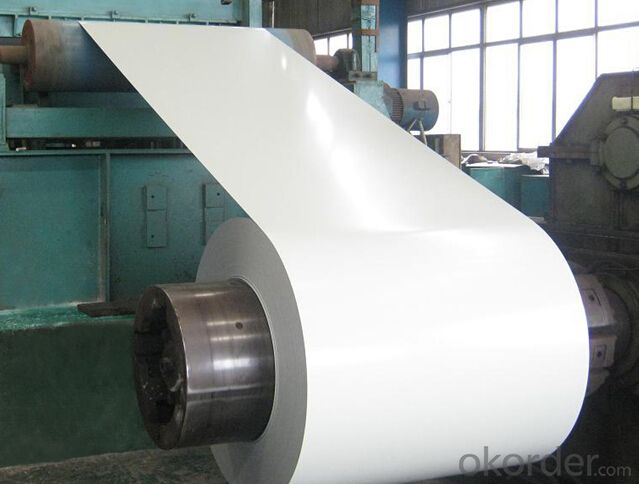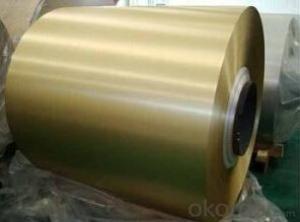Hot Prepaint Galvanized Steel Coil and PPGI for Construction
- Loading Port:
- Tianjin
- Payment Terms:
- TT OR LC
- Min Order Qty:
- 25 m.t.
- Supply Capability:
- 10000 m.t./month
OKorder Service Pledge
OKorder Financial Service
You Might Also Like
Basic description.
Surface Treatment:Coated
Technique:Cold Rolled
Standard:ASTM, JIS, GB
Application:Roof Panel,Wall Panel in Steel Structure Warehouse
Steel Grade:Q235B
Width:1000,1219,1200,1250mm
Thickness:0.17-1.0mm
Export Markets:Global
Additional Info.
Packing:Sea Packing: Standard Seaworthy Packing or Accordi
Standard:AISI, ASTM, BS, DIN, GB, JIS
Origin:Hebei, China
HS Code:72107010
Production Capacity:500, 000 Tons/Year
Product specification:
* Product Name: GALVANIZED STEEL COIL ,SGLCC
* Base Material: Galvanized Steel Coil.//SGLCC
* Width:700-,1250mm (The special width 914mm,1219mm,1220mm will be available )
* Thickness:0.3 -1.0mm Thickness tolerance: +/- 0.02mm
* Al-Zn coating: 30-150g /sq.m. or can be provided as clients' requirements
* Inner diameter of coil: 508mm&610mm.
* Packing: Standard seaworthy packing or according to user's need.
* Weight of each coil: 9 tons max
* Guarantee/ warranty
*Delivery time: Within 10-20 days.

USAGE
1.used as roof panel and wall panel in steel structure warehouse, factories, exhibition hall, container houses, cold storage,
2.it is also mainly used in light industry, automobile, construction, animal husbandry, fishery, and commerce,
PRODUCT PACKING
*Metal band strapping
*Outside diameter ring
*Label
*Protective steel sheet
*Water and rustproof paper
*Steel sheet
- Q:How do steel coils contribute to energy efficiency in buildings?
- Steel coils contribute to energy efficiency in buildings in several ways. Firstly, steel coils are used in the construction of insulated panels and roofs, which provide effective thermal insulation. This insulation helps to reduce heat transfer, keeping the interior of the building cool in hot weather and warm in cold weather. Additionally, steel coils are often used in the manufacturing of energy-efficient windows and doors. These windows and doors are designed to minimize heat loss or gain, thereby reducing the need for heating or cooling systems and saving energy. Furthermore, steel coils are also utilized in the production of energy-efficient appliances, such as refrigerators and air conditioners, which consume less electricity while providing the same level of performance. Overall, the use of steel coils in building construction and appliances contributes to improved energy efficiency, reducing energy consumption and promoting sustainability.
- Q:How are steel coils used in the production of oil and gas machinery?
- Steel coils are used in the production of oil and gas machinery as they provide essential structural support and reinforcement. These coils are typically formed into various components such as pipes, tubes, and casings, which are crucial for drilling, extraction, and transportation processes in the oil and gas industry. The strength and durability of steel coils ensure the reliability and longevity of the machinery, allowing for efficient and safe operations in the oil and gas sector.
- Q:What are the common methods of testing the strength of steel coils?
- Common methods of testing the strength of steel coils include tensile testing, hardness testing, and bend testing. Tensile testing involves subjecting the steel coil to tension until it reaches its breaking point. This test measures the maximum amount of force the coil can withstand before it fractures. It provides valuable information about the tensile strength, yield strength, and elongation properties of the steel. Hardness testing is another common method used to determine the strength of steel coils. It measures the resistance of the steel to indentation or scratching. Various methods, such as Rockwell, Brinell, or Vickers tests, are employed to measure the hardness of the steel. Hardness testing provides information about the material's ability to resist deformation or wear. Bend testing is performed to evaluate the ductility and flexibility of the steel coil. In this test, the coil is bent to a specific angle and inspected for signs of cracking or fracturing. Bend testing helps determine the material's ability to withstand bending or forming processes without failure. Other methods of testing the strength of steel coils may include impact testing, where a controlled impact is applied to the coil to assess its resistance to sudden loading conditions, and fatigue testing, which involves subjecting the coil to cyclic loading to determine its endurance limit and potential for failure under repeated stress. It is important to note that the specific testing methods employed may vary depending on the intended application and industry standards. Additionally, non-destructive testing techniques, such as ultrasonic testing or magnetic particle inspection, can be used to detect internal defects or flaws in steel coils without causing damage to the material.
- Q:How are steel coils used in the manufacturing of industrial compressors?
- Steel coils are used in the manufacturing of industrial compressors as they are shaped and formed into various components of the compressor, such as the casing, cylinder, and piston. The steel coils provide strength, durability, and stability to these components, allowing the compressor to withstand high pressure and perform efficiently in industrial applications.
- Q:How are steel coils used in the production of shipping pallets?
- Steel coils are used in the production of shipping pallets to reinforce and strengthen the structure. The coils are typically placed within the base of the pallet to provide additional support and stability, allowing the pallet to bear heavier loads and resist bending or warping during transportation.
- Q:Can steel coils be coated with weather-resistant materials?
- Yes, steel coils can be coated with weather-resistant materials such as zinc, aluminum, or organic coatings to enhance their resistance to corrosion and exposure to harsh weather conditions.
- Q:i currently have just steel guitar strings, not a fan they need replacing and i was wondering whats the difference between steel and bronze strings and or nickle strings?
- This Site Might Help You. RE: steel vs bronze acoustic guitar strings? i currently have just steel guitar strings, not a fan they need replacing and i was wondering whats the difference between steel and bronze strings and or nickle strings?
- Q:How are steel coils used in the production of metal facades?
- Steel coils are used in the production of metal facades as the primary material. These coils are unwound and then processed through various manufacturing techniques, such as cutting, shaping, and forming, to create the desired facade panels. The steel coils provide strength, durability, and versatility, allowing for the creation of aesthetically pleasing and functional metal facades in various architectural applications.
- Q:How are steel coils used in the automotive stamping process?
- Steel coils are a critical component in the automotive stamping process. These coils are essentially large rolls of steel that are unwound and fed into stamping machines. The coils are typically made of high-quality steel and come in various thicknesses and widths to meet the specific requirements of different automotive parts. During the stamping process, the steel coils are fed through a series of dies and presses that shape and form the metal into the desired automotive components. The coils are unwound and passed through a straightener to remove any bends or twists, ensuring a smooth and consistent feed into the stamping machine. The stamping machine then uses a combination of hydraulic or mechanical force to press the steel coil against a die, which is a specially designed mold that gives shape to the metal. The die is often made of hardened steel to withstand the pressure and provide accurate and repeatable results. The steel coil is fed into the stamping machine at a high speed, and as it passes through the die, the metal is formed into various automotive parts such as body panels, doors, hoods, fenders, and other structural components. The stamping process allows for high precision and consistency in producing these parts, ensuring they meet the required specifications and tolerances. Once the metal is formed, it may undergo additional processes such as trimming, piercing, or bending to achieve the final shape. These processes are often performed in subsequent stamping stations or by using progressive dies that combine multiple operations into a single pass. Overall, steel coils play a vital role in the automotive stamping process as they provide the raw material required to produce various components. The use of steel ensures the necessary strength, durability, and safety of the automotive parts while maintaining cost-effectiveness and mass production capabilities.
- Q:Can anyone suggest a free font that looks like steel with rivets? I'm looking for something industrial looking.
- Rivet Font
1. Manufacturer Overview |
|
|---|---|
| Location | |
| Year Established | |
| Annual Output Value | |
| Main Markets | |
| Company Certifications | |
2. Manufacturer Certificates |
|
|---|---|
| a) Certification Name | |
| Range | |
| Reference | |
| Validity Period | |
3. Manufacturer Capability |
|
|---|---|
| a)Trade Capacity | |
| Nearest Port | |
| Export Percentage | |
| No.of Employees in Trade Department | |
| Language Spoken: | |
| b)Factory Information | |
| Factory Size: | |
| No. of Production Lines | |
| Contract Manufacturing | |
| Product Price Range | |
Send your message to us
Hot Prepaint Galvanized Steel Coil and PPGI for Construction
- Loading Port:
- Tianjin
- Payment Terms:
- TT OR LC
- Min Order Qty:
- 25 m.t.
- Supply Capability:
- 10000 m.t./month
OKorder Service Pledge
OKorder Financial Service
Similar products
New products
Hot products
Related keywords




























